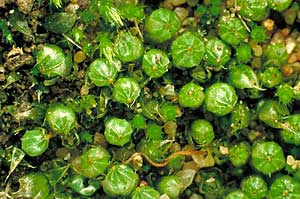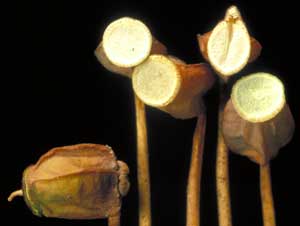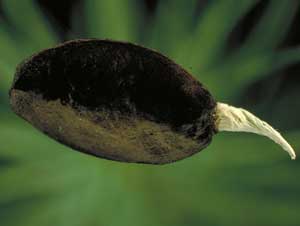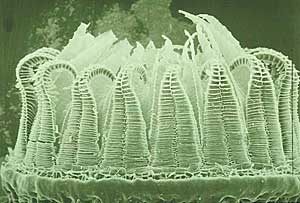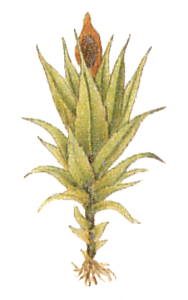
Classification and identification
Mosses (phylum Bryophyta)
The starting point is the moss classification scheme set out in the paper given in the next Reference button. That classification is based on a mixture of molecular, morphological (macroscopic and microscopic) and cell structure data and, for the sake of brevity, will be referred to as the 2000 classification on this web page. It provides a good framework on which to build a short account of the principles of moss classification and against which to contrast some findings from later studies![]() .
.
In the 2000 classification scheme the phylum Bryophyta is divided into six classes: Takakiopsida, Sphagnopsida, Andreaeopsida, Andreaeobryopsida, Polytrichopsida and Bryopsida. A number of bryologists maintain that the Takakiopsida and Sphagnopsida are so unlike any other mosses that those two classes should in fact constitute separate phyla. Those holding that view would then have two additional phyla, Takakiophyta and Sphagnophyta, with the phylum Bryophyta reduced from six to four classes. Notice that everyone agrees that the "Takakia" and "Sphagnum" groups are markedly different from all other bryophytes. The debate is about whether those two groups warrant separate divisions. Implicit in that debate are two different views about evolutionary history.
The classes in the 2000 classification vary greatly in size. About 95% of all moss species belong to the class Bryopsida, whereas Takakiopsida contains only one genus, Takakia, with just two species. It's not surprising that most of the mosses people come across belong to the class Bryopsida. Within the class Polytrichopsida the members of the class Polytrichales generally have very robust gametophytes that are readily noticed. Though much smaller in number than the Bryopsida, the Polytrichales are widespread. The next two sections will give some examples of the Bryopsida and the Polytrichales, showing you some of the variety in each group as well as some of the classificatory features to be found in those groups. The page will end with a summary of and some comments about all the classes that constitute the phylum Bryophyta.
Class Bryopsida
Given the large size of this class it's not surprising that there is considerable variety in both the gametophytes and sporophytes of its members.
The gametophytes of Goniomitrium acuminatum (Pottiaceae, Pottiales) (right) grow to only a few millimetres in height and the short-stalked, spherical spore capsules are only 1-2 millimetres in diameter. The accompanying photo is dominated by immature sporophytes. By contrast the species of Papillaria (Meteoriaceae, Hypnales) ![]() may grow as curtains to well over a metre in length.
may grow as curtains to well over a metre in length.
The gametophytes of mosses in the family Pottiaceae are typically short-stemmed, tufty plants, often growing gregariously and in harsh, exposed habitats. Examples, other than Goniomitrium, are Tortula princeps ![]() and Trichostomum brachydontium
and Trichostomum brachydontium ![]() . That's not to say that all short-stemmed, tufty mosses of harsh habitats are members of the Pottiaceae. Gigaspermum repens
. That's not to say that all short-stemmed, tufty mosses of harsh habitats are members of the Pottiaceae. Gigaspermum repens ![]() (Gigaspermaceae, Funariales) is a good counter-example. It's also not the case that all members of the Pottiaceae have short, tufty gametophytes. The stems of Triquetrella papillata
(Gigaspermaceae, Funariales) is a good counter-example. It's also not the case that all members of the Pottiaceae have short, tufty gametophytes. The stems of Triquetrella papillata ![]() can grow to several centimetres in length and branch so that the gametophytes grow as mats on the ground. However, long stems in mat-like growth are far more characteristic of the orders Hookeriales and, especially, the Hypnales. The latter is a large order with several thousand species. The order's name is derived from the genus Hypnum (in the family Hypnaceae) and here is a small but dense mat of Hypnum cupressiforme
can grow to several centimetres in length and branch so that the gametophytes grow as mats on the ground. However, long stems in mat-like growth are far more characteristic of the orders Hookeriales and, especially, the Hypnales. The latter is a large order with several thousand species. The order's name is derived from the genus Hypnum (in the family Hypnaceae) and here is a small but dense mat of Hypnum cupressiforme ![]() . This photo
. This photo ![]() shows a loose mat of Brachythecium salebrosum (Brachytheciaceae, Hypnales) growing in a lush lawn at Old Parliament House in Canberra and here is a well-developed mat of Thuidium cymbifolium (Thuidiaceae, Hypnales)
shows a loose mat of Brachythecium salebrosum (Brachytheciaceae, Hypnales) growing in a lush lawn at Old Parliament House in Canberra and here is a well-developed mat of Thuidium cymbifolium (Thuidiaceae, Hypnales) ![]() growing on a roadside embankment on Norfolk Island. From the example of Papillaria you've already seen that, rather then being confined to mat-like growth, members of the Hypnales can also grow as curtains.
growing on a roadside embankment on Norfolk Island. From the example of Papillaria you've already seen that, rather then being confined to mat-like growth, members of the Hypnales can also grow as curtains.
In each of Gemmabryum dichotomum (Bryaceae, Bryales) ![]() and Tayloria gunnii (Splachnaceae, Splachnales)
and Tayloria gunnii (Splachnaceae, Splachnales) ![]() the mouth of the spore capsule is surrounded by peristome teeth, which can help in spore DISPERSAL. Most members of the Bryopsida have spore capsules with peristome teeth. In Gemmabryum dichotomum the teeth are well-developed but in Tayloria gunnii they are rather small. By contrast the spore capsule of Physcomitrium pyriforme (Funariaceae, Funariales)
the mouth of the spore capsule is surrounded by peristome teeth, which can help in spore DISPERSAL. Most members of the Bryopsida have spore capsules with peristome teeth. In Gemmabryum dichotomum the teeth are well-developed but in Tayloria gunnii they are rather small. By contrast the spore capsule of Physcomitrium pyriforme (Funariaceae, Funariales) ![]() lacks peristome teeth. The 2000 classification uses the nature (or absence) of the peristome teeth to help define the moss orders. One of the Gemmabryum dichotomum spore capsules is still in the process of shedding its operculum, the cap that covers the capsule mouth in developing spore capsules. You can see the annulus, a connecting ring of tissue between the operculum and the capsule, in the process of being shed. The 2000 classification explicitly uses the presence of a well-differentiated annulus to help define some moss orders.
lacks peristome teeth. The 2000 classification uses the nature (or absence) of the peristome teeth to help define the moss orders. One of the Gemmabryum dichotomum spore capsules is still in the process of shedding its operculum, the cap that covers the capsule mouth in developing spore capsules. You can see the annulus, a connecting ring of tissue between the operculum and the capsule, in the process of being shed. The 2000 classification explicitly uses the presence of a well-differentiated annulus to help define some moss orders.
Class Polytrichopsida, order Polytrichales
As noted above the gametophytes of the members of the Polytrichales are generally quite robust. Polytrichaceae is the only family in this order. The gametophyte stems may be anything from just a few centimetres in height to over 60 centimetres in some species. Stems of some aquatic mosses can be quite long, but the Polytrichales are terrestrial mosses with free-standing stems. Here ![]() is a photo of a few plants of the genus Dawsonia. Here
is a photo of a few plants of the genus Dawsonia. Here ![]() is a mass of Dawsonia plants, with a human for scale. There are some robust mosses that are not in the Polytrichales. One such is the tropical genus Spiridens
is a mass of Dawsonia plants, with a human for scale. There are some robust mosses that are not in the Polytrichales. One such is the tropical genus Spiridens ![]() (Spiridentaceae, Rhizogoniales, Bryopsida) where the stems can grow to over 30 centimetres in length. However, the stems of Spiridens grow horizontally to slightly pendulously, unlike the upright growth in the Polytrichales. Spiridens is occasionally found growing on soil, but is far more commonly found growing on plants.
(Spiridentaceae, Rhizogoniales, Bryopsida) where the stems can grow to over 30 centimetres in length. However, the stems of Spiridens grow horizontally to slightly pendulously, unlike the upright growth in the Polytrichales. Spiridens is occasionally found growing on soil, but is far more commonly found growing on plants.
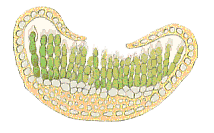 Nerves are present in the leaves of the Polytrichales and, typically, there are wall-like growths, called lamellae, running along the long nerve. The accompanying diagram shows a cross section of a leaf of the species Aloina rigida. The central brown section, several cells thick, is the nerve. On each side of the nerve the leaf is just one cell thick and is curved inwards. Each green "pillar" indicates one lamella. Remember that this is a cross-section so each green "pillar" continues back into the screen and forward out of the screen to constitute a wall-like lamella. Amongst the Polytrichales there is variation in features such as the leaf shape, leaf curl, shape and arrangement of the lamellae. These help differentiate species. The diagram is taken from Tafel 16 in W. Migula's Kryptogamen-Flora von Deutschland, Deutsch- Österreich und der Schweiz: Band 1: Moose, published in Berlin in 1904.
Nerves are present in the leaves of the Polytrichales and, typically, there are wall-like growths, called lamellae, running along the long nerve. The accompanying diagram shows a cross section of a leaf of the species Aloina rigida. The central brown section, several cells thick, is the nerve. On each side of the nerve the leaf is just one cell thick and is curved inwards. Each green "pillar" indicates one lamella. Remember that this is a cross-section so each green "pillar" continues back into the screen and forward out of the screen to constitute a wall-like lamella. Amongst the Polytrichales there is variation in features such as the leaf shape, leaf curl, shape and arrangement of the lamellae. These help differentiate species. The diagram is taken from Tafel 16 in W. Migula's Kryptogamen-Flora von Deutschland, Deutsch- Österreich und der Schweiz: Band 1: Moose, published in Berlin in 1904.
The spore capsules of the Polytrichales have peristome teeth, but not always as simple teeth. In some genera, such as Polytrichum, the apices of the peristome teeth are attached to a white, disk-like epiphragm. In Dawsonia the peristome teeth are long and somewhat hair-like.
Summary of moss classification
The following table gives you a summary of the classes in the Bryophyta according to the 2000 classification. Following the name of each class the grey text gives some information about the characteristics of the members of that class. The grey text never constitutes a full description of a class but, for the first four classes will let you see some easily described differences within that group of four and between those four and the remaining two. For each class (except the Bryopsida, where there are too many orders) there is also a list of orders and a summary of numbers of families, genera and species. For a more detailed discussion of moss classification, see the moss page on the Tree of Life website.
phylum: Bryophyta class: Takakiopsida order: Takakiales (1 family, 1 genus, 2 species) class: Sphagnopsida order: Sphagnales (1 family, 1 genus, between 100 and 300 species) order: Ambuchananiales (1 family, 1 genus, 1 species) class: Andreaeopsida order: Andreaeales (1 family, 2 genera, under 100 species) class: Andreaeobryopsida order: Andreaeobryales (1 family, 1 genus, 1 species) class: Polytrichopsida order: Tetraphidales (3 families, 4 genera, no more than about 50 species) order: Polytrichales (1 family, 23 genera, several hundred species) class: Bryopsida 16 orders, 107 families, about 880 genera, about 12,000 species
|
Nematodontous & arthrodontous
Nematodontous peristome teeth consist of whole dead cells and are evenly thickened whereas arthrodontous peristome teeth are differentially thickened and have been formed from parts of dead cells,
The majority of mosses have arthrodontous peristome teeth and an example of an arthrodontous peristome is shown in the accompanying photo. Here ![]() is a close-up of one tooth. Arthrodontous peristome teeth have considerable flexibility and can curl or uncurl in response to changes in humidity.
is a close-up of one tooth. Arthrodontous peristome teeth have considerable flexibility and can curl or uncurl in response to changes in humidity.
A proposed revision
Based on a review of the morphological and DNA evidence, the authors of the paper given in the next reference button proposed a revised classification of the mosses. Most of the proposed changes are the level of order or below in the class Bryopsida. However, they proposed the following changes to the class Polytrichopsida. The family Buxbaumiacae (with just the one genus Buxbaumia) would be placed in an order of its own, Buxbaumiales, within the class Bryopsida. In the 2000 classification this family had been a member of the order Tetraphidales. The remaining two families in the Tetraphidales would each constitute a new class, thereby creating:
class: Oedipodiopsida
class: Tetraphidopsida
This would leave the class Polytrichopsida with just the one order Polytrichales, with the one family Polytrichaceae. In the 2000 classification the class Polytrichopsida contained four families with the mouths of the spore capsules having the following characteristics:
Oedipodiaceae No peristome teeth, capsule mouth smooth
Tetraphidaceae Four peristome teeth, in one circular line
Polytrichaceae 16-64 peristome teeth, in one circular line
Buxbaumiaceae One or more rows of teeth, concentric around a truncate, pleated cone
In the revised classification this one mixed-bag has been divided into more homogenous groups.
The structure of the capsule mouth in the Buxbaumiaceae is one of the most complex in the mosses and species in the family Diphysciaceae have similar capsule mouths. Interestingly, in the 2000 classification the family Diphysciaceae was placed in the order Diphysciales within the class Bryopsida. That placement had been based on careful examination of both the fine structure of the peristome as well as molecular data. The past century has seen considerable debate about the classification of the Buxbaumiaceae and Diphysciaceae, with debate focussed on whether the complex peristome is more nematodontous, more arthrodontous or an intermediate form. Note that in the revised classification, while the Buxbaumiaceae and Diphysciaceae are placed within the class Bryopsida, they are placed in different sub-classes.
The authors of the revised classification also proposed five superclasses, for the moment numbered with Roman numerals and defined as follows:
Superclass I (containing the class Takakiopsida)
Superclass II (containing the class Sphagnopsida)
Superclass III (containing the class Andreaeopsida)
Superclass IV (containing the class Andreaeobryopsida
Superclass V
class: Oedipodiopsida
class: Polytrichopsida
class: Tetraphidospida
class: Bryopsida
This makes explicit that, in the authors' opinion, the classes Oedipodiopsida, Polytrichopsida, Tetraphidospida and Bryopsida are more closely related to each other than any of them is to any of Takakiopsida, Sphagnopsida, Andreaeopsida or Andreaeobryopsida![]() .
.
![An Australian Government Initiative [logo]](/images/austgovt_brown_90px.gif)


